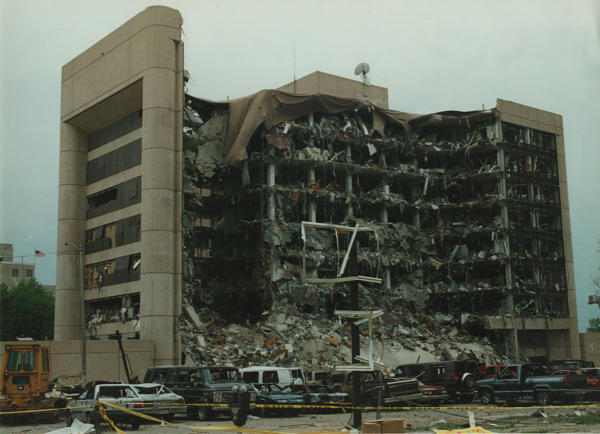Movie review by Greg Carlson
Veteran filmmaker Barak Goodman’s “Oklahoma City” is a timely and sobering historical document with unsettling connections to the ugly “alt right” rhetoric touching the increasingly tense national political climate. Following a Sundance Film Festival world premiere, the feature debuts on PBS’ “American Experience” February 7, 2017. In the film, Goodman uses the shocking events of April 19, 1995 as the foundation for a larger discussion about the toxicity of anti-government movements and the realities of homegrown acts of mayhem.
Goodman’s thesis presents two high-profile confrontations between federal authorities and private citizens as critical prelude to Timothy McVeigh’s act of devastating domestic terrorism: first, the 1992 siege of Ruby Ridge near Naples, Idaho between the Randy Weaver family, Kevin Harris, and the United States Marshals Service, and second, the David Koresh-led standoff between Branch Davidians and several groups of law enforcement and military personnel outside Waco, Texas in 1993.
Goodman’s most sobering implication leaves open to question and interpretation the idea that the aggressive, militarized tactics employed at Ruby Ridge and Waco galvanized and recruited a growing legion of believers convinced that continued government overreach would result in the loss of individual freedoms and the confiscation of weapons. Among that number was McVeigh, who visited Waco during the surreal circus preceding the fiery outcome. Eerie footage of the future bomber selling bumper stickers at a safe distance from the Branch Davidian compound plays directly into Goodman’s connect-the-dots suggestion of inciting incidents.
Given the massive amounts of televised media coverage captured and broadcast in the Oklahoma City explosion’s immediate aftermath, as well as the filmmaker’s decision to provide such detailed context prior to addressing the multitude of possible stories connected to the people who worked at the Alfred P. Murrah Federal Building, “Oklahoma City” could have been expanded to a successful multipart series like Ezra Edelman’s five episode “O.J.: Made in America.” Instead, Goodman must make difficult editorial choices that put human faces to the victims and first responders as the film covers the chaotic consequences of McVeigh’s violent act.
The deaths of 168 people included 19 children and babies, many of whom attended the day-care center inside McVeigh’s target. Goodman’s talking head interview subjects include several bereaved parents, but interestingly, “Oklahoma City” omits inclusion and discussion of the iconic, Pulitzer Prize-winning photograph of firefighter Chris Fields carrying the dying Baylee Almon. There is no shortage, however, of harrowing narratives. The vivid story of a desperate amputation in the rubble is representative of the rescue efforts and starkly contrasts deep humanity with McVeigh’s unconscionable disregard for the innocent.
As authors and experts share opinions and observations, Goodman also makes room to remind the viewer that early, erroneous reporting on the Oklahoma City bombing pointed to Middle East terrorism. That rush to judgment, which overlooked McVeigh’s brand of twisted white patriotism, may have briefly rewritten the playbook used to share breaking news with the public. The expansion of the internet and the blinding speed that prioritizes being first rather than being right has only complicated the role of news gatherers in the labeling of complicated incidents of senseless murder occurring in the years since Oklahoma City.
